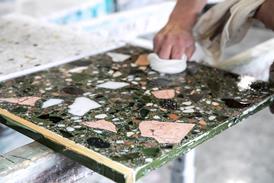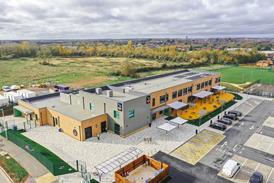In fact, it looks like little cracking of the whip will be needed. With no hiccups so far on site, the project is set to provide a few lessons in how to meet the challenges laid down by Sir John Egan in last summer's report Rethinking construction. Egan's wish list of close integration of the design and construction team, increased standardisation and a partnering approach are all helping to keep the project on track.
N G Bailey is the lead electrical contractor on the project, winning the initial £6·1 million, 14-week contract for the primary electrical services installation as well as the follow-on contract, worth another £ 3 million, for the central area works which are currently underway.
Bailey turned to its Bradford-based Major Projects division to assemble a team with the right experience and the ability to integrate into the rest of the Millennium Dome team. In come engineers from the recently-completed Heathrow Express team, complemented by members of the Glaxo Ware and Alexander House projects.
Bailey is once again linking up with its joint venture partner on the Heathrow Express project, Laing. The construction of the Dome is a jv between Laing and McAlpine, with design input from architect Richard Rogers Partnership and consulting engineer Buro Happold, responsible for structural, building services, fire, geotechnical and civil engineering design.
The North Greenwich site needed a clean up before work could begin: it has been derelict for over 20 years and once housed Europe's largest gasworks. The Blackwall tunnel added a further challenge; the tunnel cuts right under the site and its ventilation shaft is now completely enclosed by the Dome.
In fact, the Dome is something of a misnomer as in reality it is an enormous stressed cable net structure. A ring of masts 100 m tall supports a net of steel cables onto which a fabric roof is attached – the enclosed area is big enough to embrace Wembley Stadium twice over.
The building services design by Buro Happold was not easy: how do you provide adequate power when you don't know what the exhibits are? Inevitably equipment will be oversized for the job: the likely power demand is expected to be 38 MW but there is 54 MW available.
London Electricity runs power cables under the Thames from East Ham to the 180-acre site, terminating them at switchgear housed in 12 special structures positioned around the Dome. Merlin Gerin's ultra-compact Genie range of switchgear is housed in rugged all-steel housings – the 12 service cylinders are open to the elements. A network of underground trenches, only 1 m deep because of the necessary gas membrane, distribute services around the site.
LV switchboards from Square D will provide power for the exhibits and the 35 000 visitors expected each day. In a £468 000 contract, six Power Style III lv switchboards were chosen for their flexibility. "They can cope with wide variations in load, vital since the demand could not be determined," explains Brian Johnson, senior electrical engineer with Buro Happold.
With a 12 week programme, standardisation is the name of the game. The only unusual sight in the switchrooms are the U-shaped arrangement of the boards to ensure they fit in the space: a special bridge has been designed to carry the Barduct busbar from one side of the U to the other.
Passers-by will notice the recent addition of a dramatic uplighting effect on the underside of the Dome's canopy. Sportsliter floodlights from Whitecroft Lighting, 288 in all, have been installed by N G Bailey. Each fitting uses a single phase 1 kW single ended metal halide lamp from Iwasaki. Sill Lighting's projectors are used to uplight the walkways and perimeter of the Dome.
Productivity on site continues to hit targets. Integrated project management is the key: drawings are accessed via a shared IT system and N G Bailey is playing its part further down the line with electronic production control, materials procurement and planning right through to swipe cards linked to a pc to speed up the clocking on and off process.
N G Bailey's senior project manager Keith Gill puts the success of the scheme down to the fact that Bailey was paid to be on the job eight weeks early. "We were able to get familiar with the spec and re-engineer it where necessary."
The re-engineered data was then integrated with the overall project schedule and activities devised into 'workpacks': maximum package size is 400 hours and ten days duration. Several workpacks are available for each area.
A bonus system operates on site. If a 70 h package is completed in 45 h, the team get paid for 70 h. The result is programme savings and a more efficient and effective workforce.
In March, the exhibition designers will move in. If they put half as much effort into the 14 zones as the construction team have put into this extraordinary engineering feat then the Dome might just be worth a visit.
Source
Electrical and Mechanical Contractor




















